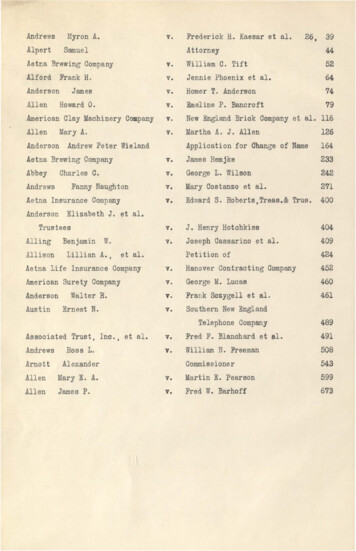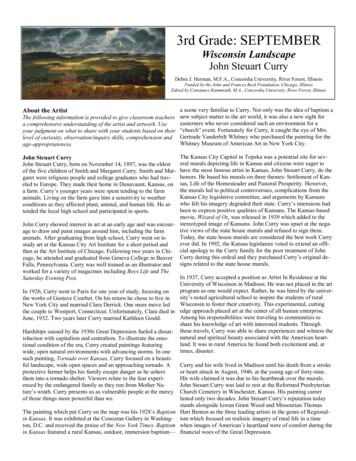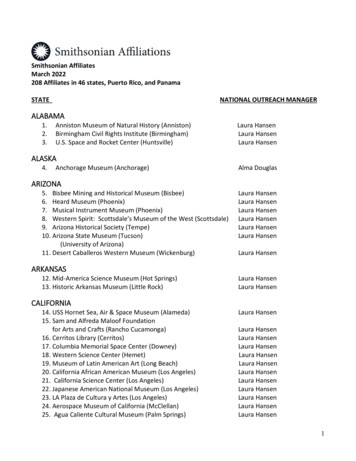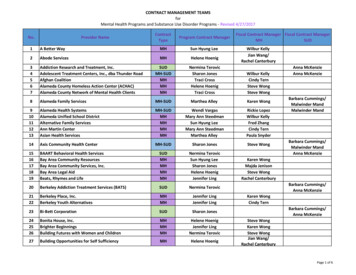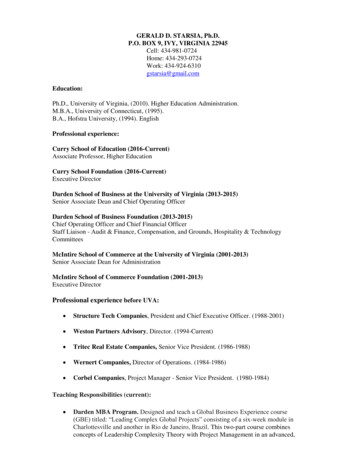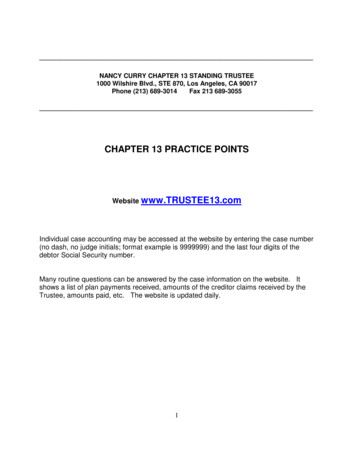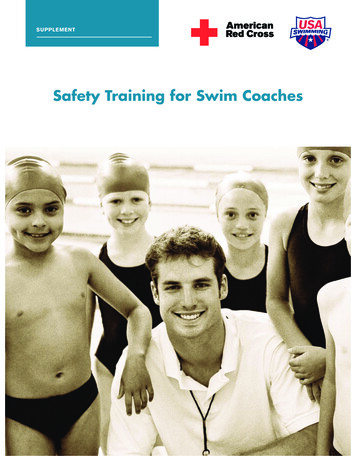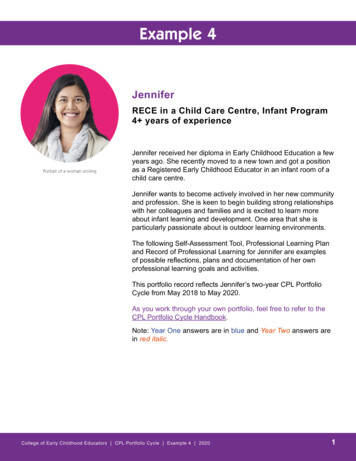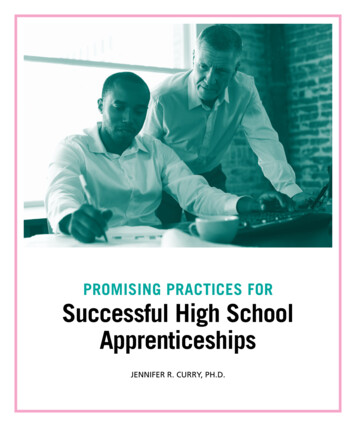
Transcription
PROMISING PRACTICES FORSuccessful High SchoolApprenticeshipsJENNIFER R. CURRY, PH.D.
Dedicated to RCC and to all of thegenerations of Appalachian parentswho dreamed of a pathway forwardfor their children to have futureswith careers that led to hope andprosperity.– JRCThe American School Counselor Association (ASCA) supportsschool counselors’ efforts to help students focus on academic,career and social/emotional development so they achievesuccess in school and are prepared to lead fulfilling lives asresponsible members of society. ASCA provides professionaldevelopment, publications and other resources, research andadvocacy to school counselors around the globe. For moreinformation, visit www.schoolcounselor.org.Copyright 2018, American School Counselor Association1101 King St., Suite 310, Alexandria, VA 22314(703) 683-ASCA, (800) 306-4722, fax: (703) 997-7572www.schoolcounselor.orgISBN 978-1-929289-57-8
PROMISING PRACTICES FORSuccessful High SchoolApprenticeshipsTABLE OF CONTENTSHow to Use this Book . . . . . . . . . . . . . . . . . . . . . . . . . . . . . . . . . . . . . . . . . . . . . . . . . . 1Methods . . . . . . . . . . . . . . . . . . . . . . . . . . . . . . . . . . . . . . . . . . . . . . . . . . . . . . . . . . . . . . . 1Book Layout . . . . . . . . . . . . . . . . . . . . . . . . . . . . . . . . . . . . . . . . . . . . . . . . . . . . . . . . . . . . 2What is an Apprenticeship Program? . . . . . . . . . . . . . . . . . . . . . . . . . . . . . . . . . . . . 3Career and Technical Education . . . . . . . . . . . . . . . . . . . . . . . . . . . . . . . . . . . . . . . . . . . . 5Student Apprenticeships and Work-Based Experiences . . . . . . . . . . . . . . . . . . . . . . . . 9Internships . . . . . . . . . . . . . . . . . . . . . . . . . . . . . . . . . . . . . . . . . . . . . . . . . . . . . . . . 10Hybrid Career Programming . . . . . . . . . . . . . . . . . . . . . . . . . . . . . . . . . . . . . . . . . . 11P-TECH . . . . . . . . . . . . . . . . . . . . . . . . . . . . . . . . . . . . . . . . . . . . . . . . . . . . . . . . . . . . 11Programs for At-Risk Youth . . . . . . . . . . . . . . . . . . . . . . . . . . . . . . . . . . . . . . . . . . . 11Interest-Based Experiences . . . . . . . . . . . . . . . . . . . . . . . . . . . . . . . . . . . . . . . . . . . 12Career-Focused Programs . . . . . . . . . . . . . . . . . . . . . . . . . . . . . . . . . . . . . . . . . . . . 13A Review of Current, Successful Apprenticeship Models . . . . . . . . . . . . . . . . . . . . . . 14Employability Skills . . . . . . . . . . . . . . . . . . . . . . . . . . . . . . . . . . . . . . . . . . . . . . . . . . 15Emotional Maturity and Growth . . . . . . . . . . . . . . . . . . . . . . . . . . . . . . . . . . . . . . 15Better But Not Perfect . . . . . . . . . . . . . . . . . . . . . . . . . . . . . . . . . . . . . . . . . . . . . . . . . . 16Promising Practices for Successful Apprenticeships . . . . . . . . . . . . . . . . . . . . . . . . . . . 17Section Summary . . . . . . . . . . . . . . . . . . . . . . . . . . . . . . . . . . . . . . . . . . . . . . . . . . . . . . . 181
234Memorandums of Understanding and Student Placements . . . . . . . . . . . . . .Apprenticeship Program Memorandums of Understanding . . . . . . . . . . . . . . . . . . .Provisions for Apprenticeships in Industries with Hazardous Occupations . . . .Memorandum of Understanding Recommendations . . . . . . . . . . . . . . . . . . . . . . . . .Case Study 2.1: Katrina’s Parents . . . . . . . . . . . . . . . . . . . . . . . . . . . . . . . . . . . . . .Case Study 2.2: Ha-Joon’s Father . . . . . . . . . . . . . . . . . . . . . . . . . . . . . . . . . . . . . . .Case Study 2.3: Jarius . . . . . . . . . . . . . . . . . . . . . . . . . . . . . . . . . . . . . . . . . . . . . . . .Section Summary . . . . . . . . . . . . . . . . . . . . . . . . . . . . . . . . . . . . . . . . . . . . . . . . . . . . . . .1921222324252627504 Accommodations . . . . . . . . . . . . . . . . . . . . . . . . . . . . . . . . . . . . . . . . . . . . . . . . .ADA and EEOC Protections . . . . . . . . . . . . . . . . . . . . . . . . . . . . . . . . . . . . . . . . . . . . . .Student Apprentices with Disabilities . . . . . . . . . . . . . . . . . . . . . . . . . . . . . . . . . . . . . .Teaching Self-Advocacy Skills . . . . . . . . . . . . . . . . . . . . . . . . . . . . . . . . . . . . . . . . .Assisting Students Hesitant to Disclose a Disability . . . . . . . . . . . . . . . . . . . . . . . .504 Apprenticeship Recommendations . . . . . . . . . . . . . . . . . . . . . . . . . . . . . . . . . . . .Case Study 3.1: Leo’s Disorganization . . . . . . . . . . . . . . . . . . . . . . . . . . . . . . . . . .Case Study 3.2: Rachel’s Migraines . . . . . . . . . . . . . . . . . . . . . . . . . . . . . . . . . . . . .Case Study 3.3: Dylan Won’t Disclose . . . . . . . . . . . . . . . . . . . . . . . . . . . . . . . . . . .Section Summary . . . . . . . . . . . . . . . . . . . . . . . . . . . . . . . . . . . . . . . . . . . . . . . . . . . . . . .Identifying and Training Supervisors: The Role of Feedbackand Evaluations in Apprenticeship Programs . . . . . . . . . . . . . . . . . . . . . . . . . .Vetting Workplace Supervisors . . . . . . . . . . . . . . . . . . . . . . . . . . . . . . . . . . . . . . . . . . .Training Workplace Supervisors . . . . . . . . . . . . . . . . . . . . . . . . . . . . . . . . . . . . . . . . . . .Teaching Apprenticeship Supervisors to Give Feedback . . . . . . . . . . . . . . . . . . . . . . .Supervision Recommendations . . . . . . . . . . . . . . . . . . . . . . . . . . . . . . . . . . . . . . . . . . .Case Study 4.1: Shea’s Supervisor . . . . . . . . . . . . . . . . . . . . . . . . . . . . . . . . . . . . . .Case Study 4.2: Carter’s Perception of Feedback . . . . . . . . . . . . . . . . . . . . . . . . . .Case Study 4.3: Alex’s Performance Evaluation . . . . . . . . . . . . . . . . . . . . . . . . . . .Case Study 4.4: Terri is Competent but Not Employable . . . . . . . . . . . . . . . . . . .Case Study 4.5: Lance . . . . . . . . . . . . . . . . . . . . . . . . . . . . . . . . . . . . . . . . . . . . . . . .Section Summary . . . . . . . . . . . . . . . . . . . . . . . . . . . . . . . . . . . . . . . . . . . . . . . . . . . . . . .Student Apprentice Development, Assessment and Accountability . . . . . .Transitioning Student Apprentices to the Workplace . . . . . . . . . . . . . . . . . . . . . . . . .Key Competencies and Employability Skills . . . . . . . . . . . . . . . . . . . . . . . . . . . . . . . . .Tracking Apprentices’ Success . . . . . . . . . . . . . . . . . . . . . . . . . . . . . . . . . . . . . . . . . . . .FERPA Waivers . . . . . . . . . . . . . . . . . . . . . . . . . . . . . . . . . . . . . . . . . . . . . . . . . . . . .Opportunities for Reflection . . . . . . . . . . . . . . . . . . . . . . . . . . . . . . . . . . . . . . . . . . . . 595960
Student Development, Assessment and Accountability Recommendations . . . . . . .Case Study 5.1: Is Casey Just Confused? . . . . . . . . . . . . . . . . . . . . . . . . . . . . . . . . .Case Study 5.2: We Need More People at the Table . . . . . . . . . . . . . . . . . . . . . . .Case Study 5.3: Carla’s Court Order . . . . . . . . . . . . . . . . . . . . . . . . . . . . . . . . . . . .Case Study 5.4: Workplace EcoMap . . . . . . . . . . . . . . . . . . . . . . . . . . . . . . . . . . . .Section Summary . . . . . . . . . . . . . . . . . . . . . . . . . . . . . . . . . . . . . . . . . . . . . . . . . . . . . . .Student Concerns and Due Process . . . . . . . . . . . . . . . . . . . . . . . . . . . . . . . . . . . .Apprentices and Worksite Bullying . . . . . . . . . . . . . . . . . . . . . . . . . . . . . . . . . . . . . . . .Workplace Discrimination and Harassment of Apprentices . . . . . . . . . . . . . . . . . . . .Termination of Student Apprentices . . . . . . . . . . . . . . . . . . . . . . . . . . . . . . . . . . . . . . .Termination and Due Process . . . . . . . . . . . . . . . . . . . . . . . . . . . . . . . . . . . . . . . . .Documentation of Due Process . . . . . . . . . . . . . . . . . . . . . . . . . . . . . . . . . . . . . . .Student Concerns Recommendations . . . . . . . . . . . . . . . . . . . . . . . . . . . . . . . . . . . . . .Case Study 6.1: Tyler . . . . . . . . . . . . . . . . . . . . . . . . . . . . . . . . . . . . . . . . . . . . . . . .Case Study 6.2: Zander’s Termination . . . . . . . . . . . . . . . . . . . . . . . . . . . . . . . . . .Section Summary . . . . . . . . . . . . . . . . . . . . . . . . . . . . . . . . . . . . . . . . . . . . . . . . . . . . . . .Career Development . . . . . . . . . . . . . . . . . . . . . . . . . . . . . . . . . . . . . . . . . . . . . . . . . .Career Theories . . . . . . . . . . . . . . . . . . . . . . . . . . . . . . . . . . . . . . . . . . . . . . . . . . . . . . . .Theory of Vocational Choice . . . . . . . . . . . . . . . . . . . . . . . . . . . . . . . . . . . . . . . . . .Theory of Circumscription and Compromise . . . . . . . . . . . . . . . . . . . . . . . . . . . . .Lifespan-Lifespace Theory . . . . . . . . . . . . . . . . . . . . . . . . . . . . . . . . . . . . . . . . . . . .Happenstance Learning Theory . . . . . . . . . . . . . . . . . . . . . . . . . . . . . . . . . . . . . . .Student Career Preparation . . . . . . . . . . . . . . . . . . . . . . . . . . . . . . . . . . . . . . . . . . . . . .Career Development Sequencing . . . . . . . . . . . . . . . . . . . . . . . . . . . . . . . . . . . . . . . . .Technology . . . . . . . . . . . . . . . . . . . . . . . . . . . . . . . . . . . . . . . . . . . . . . . . . . . . . . . . . . .Career Assessment . . . . . . . . . . . . . . . . . . . . . . . . . . . . . . . . . . . . . . . . . . . . . . . . . . . . .Understanding the College Payoff . . . . . . . . . . . . . . . . . . . . . . . . . . . . . . . . . . . . . . . .Students with Exceptionalities . . . . . . . . . . . . . . . . . . . . . . . . . . . . . . . . . . . . . . . . . . . .Engaging Parents in Career Development . . . . . . . . . . . . . . . . . . . . . . . . . . . . . . . . . .Elementary School Parents . . . . . . . . . . . . . . . . . . . . . . . . . . . . . . . . . . . . . . . . . . .Middle and High School Parents . . . . . . . . . . . . . . . . . . . . . . . . . . . . . . . . . . . . . . .Community Partners and Career Development . . . . . . . . . . . . . . . . . . . . . . . . . . . . . .Career Development Recommendations . . . . . . . . . . . . . . . . . . . . . . . . . . . . . . . . . . .Case Study 7.1: Who is Doing What? . . . . . . . . . . . . . . . . . . . . . . . . . . . . . . . . . . .Case Study 7.2: Tia the Attorney . . . . . . . . . . . . . . . . . . . . . . . . . . . . . . . . . . . . . . .Case Study 7.3: We’re Not Hiring . . . . . . . . . . . . . . . . . . . . . . . . . . . . . . . . . . . . . .Section Summary . . . . . . . . . . . . . . . . . . . . . . . . . . . . . . . . . . . . . . . . . . . . . . . . . . . . . . 182828383858585868788899091
8Developing Employability and Financial Literacy Skills . . . . . . . . . . . . . . . . . . 94Employability Skills . . . . . . . . . . . . . . . . . . . . . . . . . . . . . . . . . . . . . . . . . . . . . . . . . . . . 94Helicopter Parenting and the Workplace . . . . . . . . . . . . . . . . . . . . . . . . . . . . . . . 96Developing Employment Mindsets and Behaviors . . . . . . . . . . . . . . . . . . . . . . . . . . . . 96Project Design Process . . . . . . . . . . . . . . . . . . . . . . . . . . . . . . . . . . . . . . . . . . . . . . . 99Communication Skills . . . . . . . . . . . . . . . . . . . . . . . . . . . . . . . . . . . . . . . . . . . . . . . . . . 101Financial Literacy . . . . . . . . . . . . . . . . . . . . . . . . . . . . . . . . . . . . . . . . . . . . . . . . . . . . . . 102Financial Literacy in Elementary School . . . . . . . . . . . . . . . . . . . . . . . . . . . . . . . . . . . 102Young Ameritowne . . . . . . . . . . . . . . . . . . . . . . . . . . . . . . . . . . . . . . . . . . . . . . . . 103Lemonade Day . . . . . . . . . . . . . . . . . . . . . . . . . . . . . . . . . . . . . . . . . . . . . . . . . . . . 103Microsociety . . . . . . . . . . . . . . . . . . . . . . . . . . . . . . . . . . . . . . . . . . . . . . . . . . . . . . 103Financial Literacy in Middle School . . . . . . . . . . . . . . . . . . . . . . . . . . . . . . . . . . . . . . . 103Financial Literacy in High School . . . . . . . . . . . . . . . . . . . . . . . . . . . . . . . . . . . . . . . . . 104Preparing for Contractual Work . . . . . . . . . . . . . . . . . . . . . . . . . . . . . . . . . . . . . . 104Employability and Financial Literacy Skills Recommendations . . . . . . . . . . . . . . . . . 104Case Study 8.1: Ecosystems and Employability . . . . . . . . . . . . . . . . . . . . . . . . . . 105Case Study 8.2: Aquaponics at Brookstown . . . . . . . . . . . . . . . . . . . . . . . . . . . . 106Case Study 8.3: The St. Vrain Valley School District Innovation Center . . . . . . . 107Section Summary . . . . . . . . . . . . . . . . . . . . . . . . . . . . . . . . . . . . . . . . . . . . . . . . . . . . . . 108References . . . . . . . . . . . . . . . . . . . . . . . . . . . . . . . . . . . . . . . . . . . . . . . . . . . . . . . . . . 110LIST OF FIGURES AND TABLESFigure 1.Table 6.1Table 6.2.Table 7.1Table 7.2.Table 8.1Figure X.Elements of a U.S. Bureau of Labor Registered Apprentice Program . . . . . . . . . . . . . 5Workplace Discrimination and Definitions . . . . . . . . . . . . . . . . . . . . . . . . . . . . . . . . . . 69Holzbauer and Conrad’s Typology of Disability HarassmentCultures, Major Types and Sample Behaviors . . . . . . . . . . . . . . . . . . . . . . . . . . . . . . . . 71Holland Types with Descriptions . . . . . . . . . . . . . . . . . . . . . . . . . . . . . . . . . . . . . . . . . . 78Grade Level and Career Content Knowledge . . . . . . . . . . . . . . . . . . . . . . . . . . . . . . . . 81Sample List of St. Vrain Valley School District High Schools and Areas of Focus . . . . 97The Design Model-5 Step Process . . . . . . . . . . . . . . . . . . . . . . . . . . . . . . . . . . . . . . . . . 99LIST OF APPENDICESAppendix A. Sample Authorization for Exchange of InformationBetween School and Worksite . . . . . . . . . . . . . . . . . . . . . . . . . . . . . . . . . . . . . . . . . . . 119Appendix B. Sample Letter Inviting HR manager and Workplace Supervisorto a 504 Meeting . . . . . . . . . . . . . . . . . . . . . . . . . . . . . . . . . . . . . . . . . . . . . . . . . . . . . . 120Appendix C. Science and Employability Unit Letter to Students and Parents . . . . . . . . . . . . . . . . 121Appendix D. Science and Employability Unit Rubric . . . . . . . . . . . . . . . . . . . . . . . . . . . . . . . . . . . . 122
THE SORCERER’S APPRENTICEJohann Wolfgang von GoetheGone’s for once the old magicianWith his countenance forbidding;I’m now master,I’m tactician,All his ghosts must do my bidding.Know his incantation,Spell and gestures too;By my mind’s creationWonders shall I do.Flood impassiveWith persistenceFrom a distanceWant I rushingAnd at last abundant, massiveHere into my basin gushingCome, old broom!For work get ready,Dress yourself, put on your tattersYou’re, I know, a servant steadyAnd proficient in such matters.On two legs stand gravely,Have a head, besides,With your pail now bravelyOff, and do take strides!Flood impassiveWith persistenceFrom a distanceWant I rushingAnd at last abundant, massiveHere into my basin gushingLike a whirlwind he is goingTo the stream, and then inLike an engine he is throwingWater for my use; with flurryDo I watch the steady;Not a drop is spilled,Basin, bowls alreadyAre with water filled.Fool unwitty,Stop your going!OverflowingAre the dishes.I forgot the charm; what pity!Now my words are emptyFor the magic charm undoingWhat I did,I have forgotten.Be a broom!Be not renewingNow your efforts, spell-begotten!Still his work abhorrentDoes the wretch resume;Where I look a torrentThreatens me with doom.No, no longerShall I sufferYou to offerBold defiance.I have brains,I am the strongerAnd I shall enforce complianceYou, hell’s miscreate abortion,Is this house doomed to perdition?Signs I see in every portionOf impending demolition.Servant, cursed and senseless,Do obey my will!
Be a broom defenseless,Be a stick!Stand still!Not impurelyShall you ravage.Wait! you savage,I’ll beset you,With my hatchet opportunelyShall I split your wood, I betThere he comes again with water!How my soul for murder itclies!First I stun and then I slaughter,That is good for beasts and witches.Well! he ‘s gone! - and brokenIs the stick in two.He ‘s not worth a token;Now I hope, I do!Woe! It is so.Both the broken1779, translation by Paul Dyrsen, 1878Parts betokenOne infernalServant’s doubling.Woe! It is so.Now do help me, powers eternal!Both are running, both are ploddingAnd with still increased persistenceHall and work-shop they are flooding.Master, come to my assistance!Wrong I was in callingSpirits, I avow,For I find them galling,Cannot rule them now.“Be obedientBroom, be hidingAnd subsiding!None should everBut the master, when expedient,Call you as a ghostly lever!”
HOW TO USE THIS BOOKMaybe it won’t work out. But maybe seeingif it does will be the best adventure ever.– Author UnknownLearning is a process that may evoke both excitement and frustration for individuals.As with the famous poem “The Sorcerer’s Apprentice” (von Goethe, 1779), studentsoften want a balance of support from a mentor along with freedom to experiment,opportunities to try out new skills and a chance to test their own knowledge. Onoccasion, students need a more knowledgeable and practiced expert to guide themback to safety when they begin to feel they’ve reached the boundaries of theircompetence or that they’ve stretched beyond their own limits and need a helpinghand to accomplish the goals or tasks assigned to them. Similar to the sorcerer’sapprentice, many new learners have felt the range of emotions expressed in vonGoethe’s famous poem: curiosity, enthusiasm, frustration, fear, rebellion and relief.Admittedly, sorcery generally isn’t a college-bound, career or technical pathwayin most high schools today. However, apprenticeships have re-emerged as a valuedlearning experience across many types of secondary and postsecondary educationprograms. To provide an effective apprenticeship experience, educators need tobe aware of the promising practices that may help mitigate ethical issues and legalliabilities while also promoting the best possible academic and career outcomes forstudent apprentices.MethodsThis book was designed using a variety of research methods. Due to the exploratorynature of U.S. apprenticeships, mixed methods were employed including contentanalysis of documents, qualitative case study based on individual and focus-groupdata using semi-structured interview protocols and triangulation of interview datawith various supporting documents. All participants were volunteers, and informedconsent was based on Institutional Review Board ethical codes. Analysis includedtranscription, coding, establishment of themes for each question and triangulationof documents. This book was reviewed through a variety of methods including peerreview, focus groups and a structured review process with a Southeastern Conferencepeer institution, the University of South Carolina.PROMISING PRACTICES FOR SUCCESSFUL HIGH SCHOOL APPRENTICESHIPS 1
However, in spite of the research foundations utilized, this book is written in afundamental style with a focus on practicality. Whether your district and state areworking with a third-party provider or if you are considering piloting apprenticeshipswith a small group of students in the future, this book is meant to help younavigate through some of the nuts and bolts of apprenticeship program design andimplementation. The main goal of this text is how to create a smooth transition withindustry partners, community and technical colleges, students and parents. A keyfunction of this book is to reduce liabilities and promote success for your school on thejourney to successful apprenticeship programming.Book LayoutThis book is meant to help your group (e.g., school, district, career center) thinkabout how you will handle problems as they arise and to foster the best possibleenvironment for student apprentices in your community. Preparation is alwayspreferable to reactivity. The activities in this book provide an opportunity for yourgroup to anticipate future dilemmas and formulate potential action plans. If you getto a section where you are unsure of how you might handle a particular problem,then this is a potential area where your group may want to pay extra close attentionand think about details, have meaningful conversation and formulate useful solutions.Remember, there are no hard and fast rules. This book is meant to give you promisingpractice guidelines, so you will have to come up with the best possible solutions forthe contexts in which you work.The introduction will give you an overview of apprenticeships and the history ofhow contemporary apprenticeship programs have developed and evolved. The restof the book is divided into sections. Each section will give you pertinent literature ona topic specific to secondary school apprenticeships, recommendations, case studiesand reflection questions. The case studies are important and are based on true storiesabout real people. However, identifying information and details have been changedto mask students’ locations, personal information and the organizations involved. Thecase studies are not meant to have easy or fast conclusions but rather to stimulatefurther discussion about possible concerns and solutions.This book may be used for district-level planning, school-level planning, schoolcounselor training or coordinated training between student support and thirdparty providers. This book’s most essential function is to assist in the facilitationof conversations around these important topics. As your group gets closer toimplementing apprenticeship programs, writing apprenticeship program policies orrefining your current apprenticeship practices, it is my express hope this book willlead you to conversations with the depth and breadth necessary to make meaningfuldecisions for your schools, districts, industry partners, communities and, most of all, forthe students you serve.– Jen Curry2 HOW TO USE THIS BOOK
1What is anApprenticeshipProgram?The landmark legislation that reauthorized the Elementary and Secondary EducationAct (ESEA) (1965) that became known as (No Child Left Behind [NCLB], 2002) wasmeant to prepare every child in the United States for a four-year college degree.However, this legislation was passed without consideration for the diversity ofstudent learning styles, interests and talents. Moreover, a lack of understanding aboutoccupations, degrees needed to enter occupational fields and the payoff for collegeunderscored the bipartisan plan for NCLB (Curry & Jackson, 2015). As a result, thecore educational approach, which pushed a math and language arts curriculum butdevalued art, music, and career and technical careers, left many students without avested interested in postsecondary education.“Students who struggled with the core fours or the four-year college pressurefeel dumb; they feel they can’t be successful,” said Alicia Vanderlinden, Central HighSchool, Mesa School District, Colo. “They often think they don’t have skills or theycan’t do anything, and it isn’t true. It’s an issue that their skill sets are simply in an areathat haven’t been able to explore because of the academic options they were given,the options they were limited to so far.”The latest ESEA reauthorization, known as the Every Student Succeeds Act, signedinto law in 2015, has allowed for a broader and more diverse curriculum with a focuson many postsecondary paths including certificate programs, career and technicaldegrees, associate degrees, four-year college and beyond. This revised understandingof postsecondary education, with a value on the college payoff for many types oftraining and credentialing, has led to a renewed understanding that students maybenefit from diverse educational programs more inclusive of various career pathways.PROMISING PRACTICES FOR SUCCESSFUL HIGH SCHOOL APPRENTICESHIPS 3
Today, schools are being pushed to consider how to integrate career and collegereadiness in the form of career and technical education, rigorous college preparatoryofferings and employability skills training throughout the K–12 experience (Curry &Milsom, 2017).Some of the push for this more comprehensive view has come from U.S. industries.Many companies indicate they have high-paying positions that have gone unfilled dueto a lack of qualified applicants to hire. The lack of suitable applicants stems from theapparent absence or limit of competent, credentialed individuals to fill these positionsor the lack of individuals with employable skills. One way to prepare a workforcesuitable for hire is to consider how to implement credentialing and employabilityskills training in U.S. secondary schools. A viable solution to both of these issues isto allow students to have workplace experiences in high school, such as high schoolapprenticeships.Although there is more than one way to design and define an apprenticeshipprogram, a registered apprenticeship program, according to the U.S. Department ofLabor (n.d.), must have key components in place. These components include: business involvement structured, on-the-job training related instruction rewards for skill gains national occupational credentialingSpecifically, business involvement is essential at every level of the program,including program design. Businesses help designate and establish the competenciesnecessary for apprentices to acquire to demonstrate skill attainment. They alsoprovide venues in which apprentices procure initial employment, and businessesconnect apprentices to the workplace mentors that will train and support them.Structured, on-the-job training involves purposeful, productive hands-on learning.By working alongside a mentor and practicing the daily skills and knowledge neededto master the competencies for a specific occupation apprentices are given anopportunity to learn in a real-world setting.Related instruction is curriculum that complements the on-the-job training.This curriculum provides the apprentice with the academic knowledge necessary tobe proficient in the chosen work. The curriculum may be delivered in a variety ofeducation venues such as community college, high school, technical school or at theworksite.Rewards for skill gains underscores the value of continual growth. As theapprentice gains skills, knowledge and experience throughout the program, theapprentice’s responsibilities increase. The apprentice’s wage also increases.The national occupational credential ensures apprentices leave the registeredapprenticeship program fully proficient in knowledge and skills to enter a givenoccupation. If students have mastered these skills and knowledge, they are given acredential that vouches for this mastery and their readiness to enter the workforce in agiven occupation. This credential has standard recognition across the industry in whichthe apprentice is employed (U.S. Department of Labor, n.d.). Throughout this book, theterm apprenticeship program is used interchangeably with registered apprenticeshipprogram, meaning a program that contains the aforementioned elements.4 CHAPTER 1: WHAT IS AN APPRENTICESHIP PROGRAM?
There are myriad benefits to both student apprentices and employers forparticipation in a registered apprenticeship program. For the apprentice, thefollowing benefits are well-documented and supported in data and literature: career training education including credit toward an associate or bachelor’s degree a competitive salary a nationally portable credential The benefits to industry include: creation of a stable and reliable pipeline of workers increased knowledge transfer improved employee retention up to 91 percent a systematic method of training that is also customizable a safer workplace (U.S. Dept. of Labor, tionReward forskills gainFigure 1. Elements of a U.S. Bureau of Labor Registered Apprentice ProgramCareer and Technical EducationBefore discussing promising practices of modern-day apprenticeships, it is important tounderstand the history and development of apprenticeship programs in context. Often,people assume apprenticeships are part of an effort to bring back vocational educationto secondary schools. There are misconceptions about which students might qualify forapprenticeships and how apprenticeships might fit in the school’s larger curriculum.PROMISING PRACTICES FOR SUCCESSFUL HIGH SCHOOL APPRENTICESHIPS 5
Students in in various secondary pathways can benefit from apprenticeships,but we’ll start by reviewing career and technical education (CTE). According to theNational Center for Education Statistics (NCES), there are myriad differences betweenthe vocational education and training (vo-tech) programs launched in the UnitedStates in the 1960s and today’s CTE programs. The main areas of educational focus forstudents in vocational education programs were: agriculture business and office marketing and distribution health home economics technical education trade and industryAt the time vo-tech programs hit their peak, in 1992, about 8 percent of highschool students were primarily enrolled in vo-tech program tracks (U.S. DOE, 1992).However, according to NCES, some of the vo-tech programs did not trai
Water for my use; with flurry Do I watch the steady; Not a drop is spilled, Basin, bowls already Are with water filled. Fool unwitty, Stop your going! Overflowing Are the dishes. I forgot the charm; what pity! Now my words are empty For the magic charm undoing What I did, I have forgotten. Be a broom! Be not renewing Now your efforts, spell .
